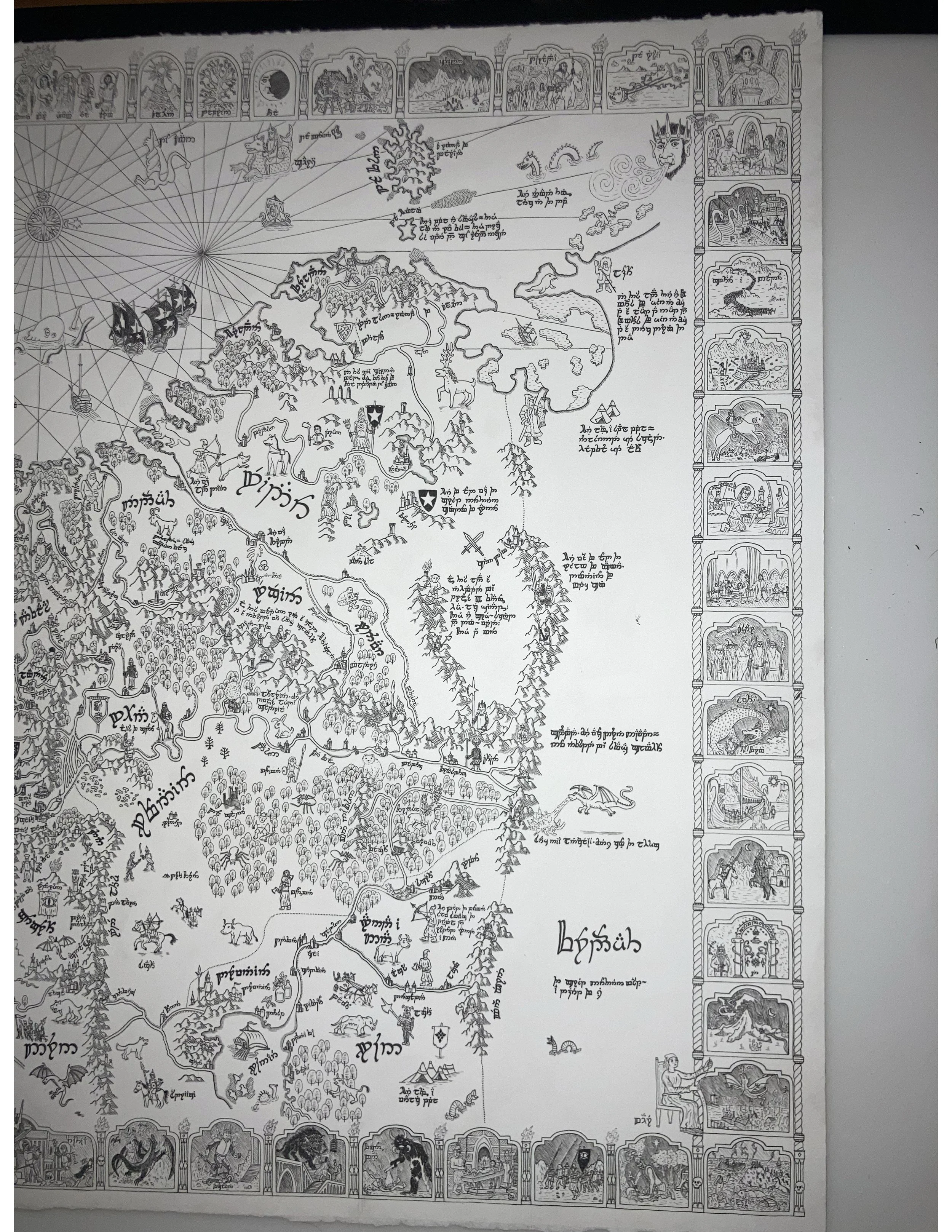Beregond’s Map of Middle Earth
Beregond’s Map: 22x30 inches, Arnhem 1618 art paper, Ticonderoga pencils, Sigma Micron pens with archival ink
Greetings and salutations! Apologies for the delay, but the wait is finally over. I finished work on my map of Middle Earth at 5am on a Thursday, just in time to get it scanned and order prints for a lovely festival we attended in Pennsylvania called Forrest of the Fae. Definitely check them out here if you get the chance; we have every expectation of joining them next year.
I am especially excited about this project, my latest map. I drew it from the perspective of a Gondorian cartographer in the late Third Age, after Sauron's return to Mordor but before his defeat in the War of the Ring. The map is oriented to the West, towards Numenor-beneath-the-waves and the Undying Lands, and the geography is somewhat distorted, especially the further one gets from Gondor, to reflect the limits of premodern mapmaking technology.
The map features various inscriptions in Tengwar as well as an iconographic border depicting scenes from the Silmarillion. I've recently acquired a light-box and will be able to trace a second version of the map to make a watercolor edition. The black and white original has already been sold (though my first draft using the Pentel Energel pens has not), but the watercolor original will also be up for sale once I finish it sometime next year, and I’ll get the scan so that we can have colored prints as well.
I’ll be sharing a translation of the map in the coming weeks, for any who are interested.
Southern half of Beregond’s map
Northern portion of Beregond’s Map
Scale for Middle Earth, units in Lár
In referencing various historical maps, especially Linschoten’s work, I knew I wanted to include a scale on Beregond’s map. I had to determine the unit of distance used by Gondorians - Lár, roughly a league, or three miles, about as far as an army marches without taking a breather. I made certain that the scale would be fairly accurate with regard to distances in and around Gondor itself by referencing the scale in Tolkien’s book maps and converting miles to Lár. I had to determine how many Lár to include on the scale - would it be 0-100, counting in increments of ten, or some other number? As it turns out, the Elves and some of the learned men use base 12 (and Beregond’s map is supposed to be in Sindarin, which could be used among the learned of Gondor similar to the use of Latin as a language of religious and academic import in medieval and early modern Europe). That’s why the scale goes from 0 to 144 in 12 increments of 12 Lár each.
“This sovereign is called Marwan. He is the noblest and richest of all Harad. He commands an army of 864 Mûmakil, 60,000 riders, and countless men.”
There is one other significant place where I make use of numbers - in the inscription near powerful Haradrim King Marwan, inspired by the Catalan Atlas’s depiction of Mansa Musa and its description of a North African Sultan. “This sovereign is called Marwan. He is the noblest and richest of all Harad. He commands an army of 800 Mûmakil, 60,000 riders, and countless men.” Until I was working on my updated version of the map using waterproof archival ink and calligraphy pens, it didn’t occur to me that 800 and 60,000 are not nice round numbers in base 12, so they would come across as oddly specific estimates, especially for guessing the size of a foreign army, which is likely wildly overestimated to begin with. On the physical original that I scanned to make prints, I corrected 800 (represented in base 12, hereafter indicated by bold text, as 568) to 864, a nice round number in base 12: 6(12^2), represented as 600. But dingus that I am, I just figured that since 60,000 is already divisible by 12 that I’d leave it as is - but 60,000 is only evenly divisible by 12 once, so it would be a sort of oddly specific estimate, written as 2A880 where A=10. I just got around to rounding this number out to 62,208 - which is 3(12^4), or 30,000.
“This sovereign is called Marwan. He is the noblest and richest of all Harad. He commands an army of 864 Mûmakil, 62,208 riders, and countless men.”
The first batch of 21 ;) maps that we ordered all contain the numbers 864 and 60,000. All subsequent maps contain and shall forevermore contain the numbers 864 and 62,208.
Just a wee fix. By the way, this is part of the reason Biblical and and other ancient texts often provide what seem to us to be oddly or impossibly specific estimates - many premodern societies used base 12, base 6, or another base system for counting.
Well gang, that’s all for this time. In case you’re local and would like to come chat with us about maps, we will be at the Arts On Market in Chapel Hill on November 23rd. Check out their website here for more information. And thanks again for tuning in! It’s been a blast working on and finishing up this project, but as always, there are many more in the planning stages that we can talk about next time. Until then!






